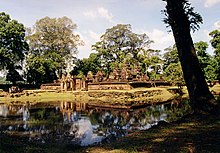بانتی سری
| بانتی سری | |
|---|---|
| ប្រាសាទបន្ទាយស្រី (خمر) Banteay Srei (انگلیسی) | |
 موقعیت در کامبوج | |
| اطلاعات جغرافیایی | |
| دستگاه مختصات جغرافیایی | ۱۳°۳۵′۵۶″ شمالی ۱۰۳°۵۷′۴۶″ شرقی / ۱۳٫۵۹۸۸۹°شمالی ۱۰۳٫۹۶۲۷۸°شرقی |
| کشور | کامبوج |
| Province | سیم ریپ |
| بخش | بانتی سری |
| موقعیت | آنگکور |
| اطلاعات فرهنگی | |
| Sanctum | شیوا و پارواتی با بسیاری از خدایان هندو دیگر |
| اطلاعات معماری | |
| معماری | معماری خمر |
| History | |
| تاریخ ساخت | 967 |
| موسس | یجنوارها |
بانتی سری (خمر: បន្ទាយស្រី، Banteay Srei) معبدی از قرن دهم میلادی در کامبوج است که به خدایان هندو شیوا و پارواتی اختصاص یافته است.[۱] این معبد در منطقه انگکور، در نزدیکی تپه پنوم دی، در شمال شرقی معابدی که زمانی متعلق به پایتختهای قرون وسطایی یاوشوداراپورا و انگکور تام بودند؛ واقع شده است.[۱]
بانتی سری عمدتاً از ماسهسنگ قرمز ساخته شده است؛ که این ماده با حکاکیهای تزئینی ظریف دیوارها که هنوز هم قابل مشاهدهاند؛ سازگاری دارد. خود ساختمانها از نظر مقیاس، بهطور غیرمعمولی کوچک هستند؛ بهویژه زمانی که با استانداردهای ساخت و ساز آنگکوری اندازهگیری میشوند. این عوامل باعث شده است که این معبد در میان گردشگران بسیار محبوب باشد و به عنوان جواهر هنر خمر مورد تحسین قرار گیرد.[۲]
کتابشناسی
[ویرایش]- Albanese, Marilia (2006). The Treasures of Angkor (Paperback). Vercelli: White Star Publishers. ISBN 88-544-0117-X.
- Cœdès, George / Dupont, Pierre: "Les stèles de Sdŏk Kăk Thoṃ, Phnoṃ Sandak et Práḥ Vihằr", BEFEO XLIII, 1943, pp. 56–154.
- Finot, Louis / Parmentier, Henri / Goloubew, Victor: Le temple d’Īçvarapura, Paris: G. Vanoest, 1926 (Mémoires archéologiques I).
- Freeman, Michael; Jacques, Claude (2003). Ancient Angkor (Paperback). Bangkok: River Books. ISBN 974-8225-27-5.
- Glaize, Maurice (2003 edition of an English translation of the 1993 French fourth edition). The Monuments of the Angkor Group. Retrieved 14 July 2005.
- Higham, Charles (2001). The Civilization of Angkor. Phoenix. شابک ۱−۸۴۲۱۲−۵۸۴−۲.
- Inscriptions du Cambodge Éditées et traduites par G[eorge] Cœdès. Vol. I, Hanoi, 1937.
- Jessup, Helen Ibbetson (2004). Art & Architecture of Cambodia. Thames & Hudson. pp. 99–104.
- Polkinghorne, Martin (2008). Khmer decorative lintels and the allocation of artistic labour, in Arts Asiatiques 63: 21–35.
- Roveda, Vittorio (1997). Khmer Mythology: Secrets of Angkor. New York: Weatherhill (this work should be used with caution. While it is thorough in its treatment of Angkorian representational art, and contains many useful photographs, it is sometimes inaccurate in its characterization of the underlying Indian myths, and does not reflect a thorough investigation of sources for those myths).
- Bruno Bruguier, Jean-Baptiste Chevance, Olivier Cunin, (2020). Les "marches d'Angkor". Guide archéologique du Cambodge, tome 6, JSRC. شابک ۹۷۸۹۹۹۵۰۵۵۵۴۷.
نگارخانه
[ویرایش]جستارهای وابسته
[ویرایش]پانویس
[ویرایش]پیوند به بیرون
[ویرایش]در ویکیانبار پروندههایی دربارهٔ بانتی سری موجود است.
- اداره آپسارا بانتی سری
- Banteay Srei - Images of parts of the temple no longer accessible to visitors توسط Wayback Machine (بایگانیشده ۱۱ اکتبر ۲۰۰۷)
- پروژه تصویرسازی انگکور: بانتی سری
- تصاویر بانتی سری

![بانتی سری (ارگ زنان) نام امروزی معبد خمری قرن دهم میلادی است که در اصل به خدای شیوا تعلق دارد.[۳]](http://upload.wikimedia.org/wikipedia/commons/thumb/9/92/Banteay_Srei_full.jpg/180px-Banteay_Srei_full.jpg)